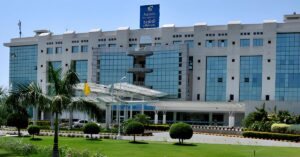Best Doctors in India for Wilson's Disease Treatment
Best Hospitals in India for Wilson's Disease Treatment
- City: Mumbai, India
Hospital Highlights:
- Fortis Hiranandani hospital was established in 2007.
- The hospital is an advanced tertiary care, multi-specialty hospital equipped with 149 beds.
- The hospital is equipped with a super ICU to provide emergency medical care to critically ill patients.
- The hospital is NABH accredited.
- The critical care facility in the hospital is augmented with the state-of-the-art facilities that facilitate speedier diagnosis and efficient monitoring.
- The hospital provides specialty medical services in cardiology, orthopedic science, pediatric science, neurology, diabetic care, urology, nephrology, ENT, obstetrics, gynecology, cosmetic surgery, bariatric surgery, neuro and spine care.
- City: Gurugram, India
Hospital Highlights:
- W Pratiksha Hospital, Gurugram, is one of the best hospitals in the NCR region. It is also a top hospital in India for IVF. Since its inception, the hospital has performed over 5500 successful IVFs. The hospital also specializes in gynecology.
- With over 20 years of experience in providing quality healthcare, the hospital is known as one of the most trusted and valued health providers in India.
- Equipped with world-class medical facilities and advanced technology, the hospital’s doctors and clinicians also have a track record of delivering excellent results. The hospital is also known for focusing on preventive well-being as much as on curative treatment.
- The hospital has earned the trust of its patients, by providing the best available treatments at affordable costs.
- City: Gurugram, India
Hospital Highlights:
- Paras hospital was established in 2006 and is the 250 bedded flagship hospital of Paras Healthcare.
- The is supported by a team of doctors of international and national repute.
- The hospital is NABH accredited and also the first hospital in the region to have a NABL accredited laboratory.
- The hospital provides specialty medical services in around 55 departments including Neurosciences, Joint Replacement, Mother & Child Care, Minimal Invasive Surgery, Gynecology and Obstetrics, Ophthalmology, Dermatology, Endocrinology, Rheumatology, Cosmetic and Plastic surgery.
- The hospital is equipped with state-of-the-art technologies.
- City: Kolkata, India
Hospital Highlights:
- Fortis Hospital, Anandapur, Kolkata is a world-class super-speciality equipped with the latest technologies in the medical world.
- The hospital is NABH accredited.
- This state-of-the-art facility specializes in cardiology and cardiac surgery, urology, nephrology, neurosciences, orthopaedics, digestive care, emergency care and critical care.
- The hospital, governed by integrated Building Management System (IBMS), has a pneumatic chute system, for quick vertical and horizontal transportation between floors, facilitating speedy transfer of patient specimens, documents, reports, and medicines to the concerned departments.
- The hospital also has a nephrology department with over 28 advanced dialysis units.
- City: Mumbai, India
Hospital Highlights:
- SL Raheja hospital is a 140-bed multi-specialty tertiary care hospital that is being managed by Fortis Healthcare Ltd.
- The hospital is a benchmark in healthcare and medical facilities in the neighborhood of Mahim & the western suburbs.
- L.Raheja Hospital, Mahim has one of the most effective ICU and Casualty care services.
- The hospital provides specialty medical services in Cardiology, Oncology, Neurology, Orthopedics, Mother & Child Care, and in Diabetes.
- City: Mumbai, India
Hospital Highlights:
- Wockhardt Hospitals were established in the year 1973, originally called First Hospitals and Heart Institute.
- Wockhardt Hospitals are super specialty health care networks in India, nurtured by Wockhardt Ltd, India’s 5th largest Pharmaceutical and Healthcare company.
- Wockhardt Hospitals is associated with Partners Harvard Medical International, an international arm of Harvard Medical School, USA.
- Wockhardt Heart Hospital performed India’s first endoscopic heart surgery.
- The hospital has a state-of-the-art infrastructure equipped with the latest technologies and modern equipment.
- It has special Centers of Excellence dedicated to the major specialties to provide hassle-free and high-quality clinical care.
- City: Gurugram, India
Hospital Highlights:
- The CK Birla Hospital in Gurugram is a NABH-accredited multi-specialty hospital.
- The hospital strives to increase the quality of healthcare by focusing on UK NHS nurse and midwife training requirements. Policies and practices derived from the National Institute for Health and Treatment Excellence (NICE) recommendations in the United Kingdom ensuring that a strong focus on safety, high-quality clinical care, and sanitation is maintained.
- The hospital’s cutting-edge technology and facilities allow for real-time communication and seamless collaboration among caregivers, ensuring accuracy and the best possible results. Those with foreign experience and accreditations make up part of the hospital’s team of clinicians.
- City: Ahmedabad
Hospital Highlights:
- As a member of the Apollo Hospitals Group, Apollo Hospitals International Limited, Ahmedabad is one of the most popular and sought-after medical facilities in Gujarat.
- Through its 6 Centres of Excellence and various affiliated branches, which cover all specialties and subspecialties, the hospital provides the most advanced clinical services.
- Since its inception in 2003, the hospital has been providing each patient with the most up-to-date medical equipment and state-of-the-art technology.
- With more than 150 successful organ transplants, including liver and renal transplants, the facility has been able to build a strong and extensive organ transplant program.
- In addition to performing 600 surgeries and caring for over 1800 patients on an IP basis, the hospital sees more than 18,000 patients on average in the outpatient department.
- With one of the biggest cardiology teams in the area, the hospital provides state-of-the-art regional care treatment in Cardiac Sciences.
- Additionally, the hospital offers a broad range of Neuro Interventional techniques to help stroke patients recover more quickly.
- City: Noida, India
Hospital Highlights:
- Jaypee Hospital is the flagship hospital of the Jaypee Group.
- This hospital has commissioned 525 beds in the first phase and has been planned and designed as a 1200 bedded multi-specialty facility.
- It holds the accreditation of the NABH and NABL.
- The hospital has state-of-the-art infrastructure equipped with the latest technologies and modern equipment like 64 Slice PET CT, Dual Head 6 Slice SPECT CT, Gamma Camera, and Da Vinci Robotic Surgery for comprehensive robotic surgical solutions.
- It has special Centers dedicated to the major specialties to provide hassle-free and high-quality clinical care.
- City: Mumbai, India
Hospital Highlights:
- Reliance Hospital is one of the best super-specialty care hospitals in Navi Mumbai.
- The main purpose of this hospital is to become a trustworthy place for the best health and hope for society. The hospital is well connected to the suburbs of Mumbai and Navi Mumbai.
- The hospital has various specialty departments, viz., Accident & Emergency, Anesthesiology, Dental Services, Dermatology, Diabetology, Dietetics Nutrition, Endocrinology, ENT, Gastroenterology, General Surgery, Gynaecology And Obstetrics, Hepato Pancreato Biliary Surgery, Infectious Disease, Internal Medicine, Interventional Radiology, Laboratory Medicine, Minimal Access Laparoscopic Surgery, Nephrology, Neurosciences, Opthalmology, Orthopaedics, Paediatrics, Pain Management Palliative Care, Physical Medicine Rehabilitation, Plastic And Reconstructive Surgery, Psychiatry, Pulmonary Medicine, Radiology, Rheumatology, Transplant, Urology Andrology, Vascular Surgery
Wilson’s disease
Wilson’s disease is a rare inherited disorder which can cause copper to accumulate in your brain, liver, and other vital organs. Most people with this condition are diagnosed between the ages of 5 and 35, though it can sometimes even affect older people. The condition is known to affect 1 to 30,000 people worldwide.
In a healthy body, the liver filters out any excess copper and releases it through urine. However, in people having Wilson’s disease, the liver is unable to remove the extra copper properly. The extra copper then builds up in organs like the brain, the liver, and the eyes.
In order to stop the progression of the condition, early diagnosis is crucial. Delaying treatment or not receiving it, can lead to brain damage, liver failure, or other life-threatening conditions.
Symptoms
Wilson’s disease can be present at birth, but signs and symptoms generally appear only after the copper builds up in the brain, liver, or other organs. Signs and symptoms can vary depending on the parts of your body, which are affected by the condition.
Some of the symptoms can include:
- Fatigue
- A yellowing of the skin as well as the whites of the eye
- Fluid buildup in the legs or abdomen
- Golden-brown eye discoloration
- Problem speaking or swallowing or physical coordination
If you experience any symptoms that worry you, you should consider seeing your doctor.
Causes
Wilson’s disease is inherited as an autosomal recessive trait. This means that in order to develop the disease, you must inherit a copy of the defective gene from each parent. If you receive only one of the genes, you will not get ill yourself, though you will become a carrier and can pass on the gene to your child.
You are at an increased risk of having this condition if your parents or siblings have it.
Diagnosis
Diagnosing Wilson’s disease can be a challenge. This is due to the fact that the signs and symptoms are quite hard to tell from those of other liver diseases, like hepatitis. Symptoms may evolve over time as well. Doctors can use a combination of symptoms and multiple test results to make and confirm a diagnosis.
Some of the tests and procedures that might be used include:
Blood and urine tests
Biopsy
Eye exam

Genetic testing
Treatment
First, your doctor might recommend medications that are known as chelating agents, which are able to bind copper and then prompt the organs to release it into your bloodstream. This copper is then filtered by the kidneys, after which it is then released into your urine.
Medications
Liver transplant
However, if your liver damage is quite severe, then you might need a liver transplant. A transplant involves your diseased liver being replaced by your surgeon, with a healthy liver from a donor.
Transplanted livers generally come from donors who have died. But sometimes, it can also come from a living donor, such as a family member. In such cases, the diseased liver is removed and replaced with a portion of the donor’s liver.
Complications
If left untreated, Wilson’s disease can be quite fatal. Some of the complications it can cause include-
- Cirrhosis: As the liver cells try to repair any damage which was done by too much copper, scar tissue can form in the liver.
- Liver Failure: This can occur suddenly, or may develop over the years slowly. A liver transplant might be a treatment option if so is the case.
- Kidney problems: Wilson’s disease can damage your kidneys and lead to problems, such as kidney stones as well as an abnormal number of amino acids excreted in the urine.
- Persistent neurological problems: Tremors, involuntary muscle movements, clumsy gait as well as speech difficulties generally improve with treatment for Wilson’s disease. Some people, however, suffer persistent neurological difficulty despite treatment.
- Psychological problems: These can include personality changes, irritability, depression, bipolar disorder, or even psychosis.
- Blood Problems: Blood problems may include the destruction of red blood cells or hemolysis, which can lead to anemia and jaundice.















